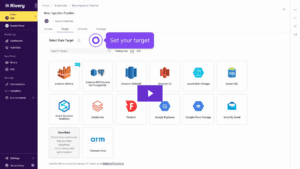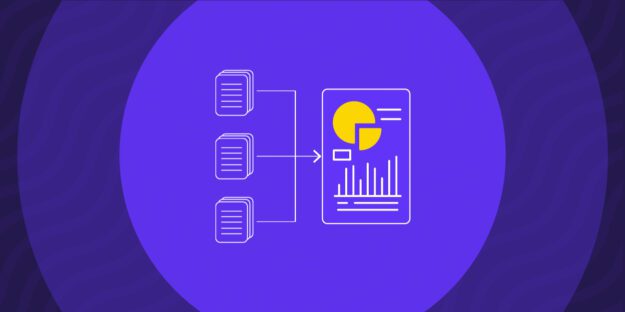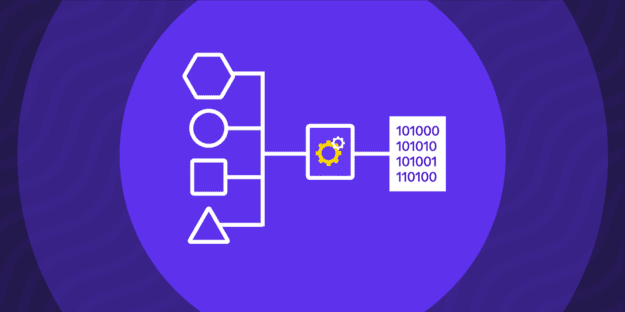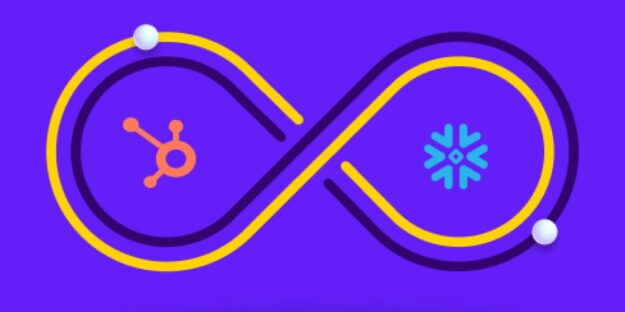Data ingestion tools are integral to any engineering job in 2024 — they make the process of transferring data significantly easier and much quicker. Since they save both time and effort, these tools are in high demand. However, choosing one of the many options available on the market can prove to be a difficult decision.
To help guide you on everything you need to know, we’ve done the market research. In this article we compare the main data ingestion tools on the market with Rivery, highlighting their strengths and weaknesses. Check out the tools:
11 of the Best Data Ingestion Tools
- Rivery
- Integrate.io
- Airbyte
- Amazon Kinesis
- Matillion
- Apache Kafka
- Apache NiFi
- Talend
- Hevo
- Adverity
- Stitch
1. Rivery
Rivery is a data ingestion tool that enables the extracting and loading of data from any source you can think of. The entire ingestion process is completed within minutes and doesn’t require any maintenance or exhausting API management.
Rivery’s self-serve REST API allows you to gather all your data from wherever you need, in one place.
Features and Highlights
The ELT process (Extract, Load, Transform) is made easier with Rivery thanks to the 200+ native connectors, and out-of-the-box data model kits that handle the E (Extract) and L (Load) of the process in a few clicks.
One of Rivery’s core strengths is its CDC solution/data replication feature. The feature is easy to use and allows users to replicate data from relational or NoSQL databases with CDC (Change Data Capture). In the case that CDC isn’t an option, there’s the option for creating custom SQL query (batch) replication.
Users of Rivery’s data ingestion software have granular control over the data ingestion and move the data around the platform or in their own file zone/lake. There’s also the possibility of configuring a custom connection without any external solutions, thus avoiding siloed replication.
In conclusion, Rivery is an all-in-one solution for data ingestion and is a cost-effective option.
Competitor Spotlight: A Deep Dive into the Alternatives
We talked about Rivery, and now it’s time to dive into other data ingestion tool alternatives:
2. Integrate.io
Integrate.io offers cloud-based data ingestion and allows users to integrate data from 200 sources and locations. It uses numerous connectors and ingestion methods and allows for process automation.
Integrate.io Key Features
Let’s look at the highlights of Integrate.io:
- Automated Interface: Little to no coding required. For advanced coding, there is a built-in Python editor
- Quick Implementation: Data pipelines can be set up within hours
- Legacy Systems Connection: Move data to the cloud and connect it to on-premise legacy systems. The two systems will be synchronized until the data is completely moved to the cloud
- API Maintenance and Integration: Users can maintain APIs directly on the Integrate.io platform and connect them to existing systems and applications.
3. Airbyte
Airbyte allows users to build new connectors in minutes thanks to its catalog of more than 300 300+ pre-built, no-code connectors. The catalog is open-source, so new connectors are added constantly to make the process even more streamlined.
Airbyte Key Features
Airbyte is fantastic for several reasons:
- Large Catalog of Connectors: With over 300 connectors, Airbyte claims to have the largest catalog in the industry
- Connector Development Kit: The kit allows users to build custom connectors and add them to Airbyte
- Self-Managed or Cloud Hosting: Users can choose to host their data on the Airbyte cloud or within their own infrastructure
- Data Transformation: The DBT integration in the Airbyte app allows for custom transformations.
4. Amazon Kinesis
The Amazon Kinesis app is a scalable data ingestion tool and lets users continuously input new data into the Kinesis data stream. The data becomes available in the Kinesis app nearly instantly.
Amazon Kinesis Key Features
If you’re considering Amazon Kinesis, here’s what you can expect:
- Serverless Streaming: Simplifies the processing and storage of any data
- Low Latency: The streaming data becomes available to analytics applications within 70 milliseconds of being collected
- Security: The data is encrypted with Kinesis Data Streams and can be accessed securely via the Amazon Virtual Private Cloud
- AWS Integrations: The Kinesis app is integrated with many other AWS services, which enables users to quickly build complete applications.
5. Matillion
Matillion dubs itself the ultimate data productivity cloud. The tool makes it easy to build pipelines and move and transform data and can provide a data warehouse to its users.
Matillion Key Features
- Batch Data Loading: With Matillion, users can load whole batches of data from both traditional and modern data sources
- Custom Connector: The feature allows users to connect any app with no-code open REST API and without any complex coding required
- Connector Library: Users don’t have to set up custom connectors for everything — Matillion has a library containing more than 150 connectors
- Change Data Capture: This feature captures all the changes that occur within the database with no impact on the end performance.
6. Apache Kafka
The Apache Kafka platform is open-source and is used for high-performance data pipelines, data integration, streaming analytics, and more.
Apache Kafka Key Features
Here are some of the key features of Apache Kafka:
- High Throughput: Messages are delivered at network-limited throughput through a cluster of machines with low latencies of 2 milliseconds
- Scalability: Users can scale production clusters and elastically expand and contract storage
- Availability: Clusters can be stretched across availability zones, or they can be connected across different geographic regions
- Permanent Storage: Data can be stored in durable and fault-tolerant clusters.
7. Apache NiFi
Apache NiFi is yet another open-source platform that provides a reliable way to process and distribute data. It’s one of the most user-friendly data ingestion tools, delivering a powerful performance.
Apache NiFi Key Features
Apache NiFi can prove useful in:
- Browser-Based Interface: The interface is designed to enable feedback, control, and monitoring and can be easily accessed via an Internet browser
- Extensive Configuration: The tool has low latency and high throughput, dynamic prioritization, and allows for runtime modification of flow configuration
- Security: Apache NiFi has HTTPS with configurable authentication strategies as well as TLS and SSH security protocols
- Data Provenance Tracking: Users can see the complete lineage of information from beginning to end.
8. Talend
Talend is a flexible, low-code platform that can collect data from various sources and transform it to deliver valuable insights. To achieve this, the Talend tool combines rapid data integration, transformation, and mapping—all to automated quality checks.
Talend Key Features
Talend has many great features, such as:
- Data Integration: The tool ingests, transforms, and maps data from various sources
- Pipeline Designer: Users can design or reuse data pipelines in the cloud
- Change Data Capture: Automated and low-code data replication
- Stitch: The self-service interface allows users to move data quickly to cloud data warehouses.
9. Hevo
Hevo Data is a zero-maintenance data pipeline platform. It allows users to sync data from numerous sources to the warehouse with minimal effort.
Hevo Key Features
Hevo is useful in the following:
- No-Code User Interface: The platform has an intuitive interface that allows users to integrate data from more than 150 sources in real time
- 100% Accuracy: The fault-tolerant architecture has minimal latency and promises no data loss. That’s how the platform delivers 100% data accuracy and 99.9% uptime
- Security: Hevo has end-to-end encryption, it’s compliant with HIPAA, SOC 2, and GDPR, and secure connection options like SSH, Reverse SSH, and VPN
- Hevo API: The API makes it easy to integrate Hevo into the data workflow and perform pipeline actions without visiting the dashboard.
10. Adverity
Adverity is a fully integrated data platform that allows businesses to automate the connectivity, transformation, and governance of data. The brand claims that this tool can improve the efficiency of data management by as much as 80%.
Adverity Key Features
- Pre-Built Connectors: The Adverity library consists of 600 pre-built data connectors
- Global Data Management: On the Adverity platform, users can manage data from different global markets
- Activity Monitor: Real-time overview of data sets to help users identify and fix errors
- Smart Naming Conventions: The intelligent naming convention tool monitors source data and sends users notifications about any incorrect data.
11. Stitch
Stitch is an ELT service that integrates data from various sources in one warehouse. The service has integrations for many software data sources and can receive data via WebHooks and an API as well.
Stitch Key Features
Here are the core features of Stitch:
- Open-Source ETL Integrations: Developers can integrate with AdWords, Hubspot, GitLab, and more with a JSON-based format
- Automated Email Alerts: Whenever errors pop up in the database, users get automated emails highlighting the issues
- Security: SOC 2 Type II certified, HIPAA BAA, ISO/IEC 27001, GDPR, and CCPA privacy/security policies
Automatic and Continuous Updates: The Stitch pipelines are automatically updated, removing the need for maintenance.
Head-to-Head Comparison: Rivery vs. Competitors
After looking at the best big data ingestion tools currently available on the market, it’s time to compare how the rest of these software solutions compare to Rivery:
Feature Comparison
Rivery has all the features users need to conduct a seamless data ingestion process. Most of the tools on this list have all of these features. However, some platforms require little to no coding, while some tools may require some coding when setting up the pipeline. Rivery stands out in that it offers both options—users can complete the process without any coding, but they can also create their own custom codes.
Ease of Use and User Interface
The Rivery interface is designed with usability in mind. It’s one of the most user-friendly tools, along with Apache NiFi, which also works as a browser extension. Rivery makes it easy to navigate the data and move around in the data lake.
Scalability and Performance
Rivery enables fast data transfers and offers built-in integrations to handle the extract and load steps of the ELT process. Other competitors vary in terms of scalability and performance, but Amazon Kinesis and Apache Kafka are fair contenders—they are built for high-performance data processing and real-time streaming.
Integration Capabilities with Various Data Sources and Destinations
The Rivery tool allows its users to extract data from any source with REST API, enabling complex integrations. Competitors like Airbyte have specialized connectors, while Talend offers flexible integrations.
Data Transformation and Enrichment Options
The data ingestion software by Rivery supports data replication with CDC, custom SQL queries, and data movement within the tool. The data transformation options differ among competitors. For example, Matillion has custom connectors, and Apache NiFi offers a runtime modification.
Real-Time vs. Batch Processing Capabilities
Rivery is the ultimate choice for batch processing with data replication and SQL query replication. Other solutions provide real-time processing, but the ones that stand out the most are Apache Kafka and Amazon Kinesis, which specialize in real-time streaming.
Support for Diverse Data Formats
Rivery supports various data types, but in the case that a data type is not supported, the tool will automatically map it as a String type. The support for data types varies, but Apache NiFi highlights the fact that it supports many different formats.
Monitoring and Alerting Features
Rivery users can set alerts that will notify them of any issues within the databases and help stakeholders manage any issues that pop up. Stitch sends out automated email alerts, while other tools may offer customizable alerts.
Pricing Models and Affordability
The Rivery prices start at $0.75 per credit with the Starter plan and rise to $1.20/credit with the Professional plan. The company also offers an Enterprise plan that offers services tailored to their needs, so the price varies depending on what the user needs. The competitors’ prices vary; there are open-source options like Apache Kafka, but there are also subscription models like Integrate.io.
Customer Support and Community Resources
The Rivery customer support is available via email and through the website via the contact form. Support is helpful and responsive, but some competitors like Hevo and Integrate.io also offer Live Chat options.
Use Cases and Success Stories
The Rivery data ingestion tool has helped many businesses improve their day-to-day operations. A prominent example is Preqin, an investment data company. The company decided to use Rivery because it offered instant data capture that will provide real-time information to their clients. Other key factors for choosing Rivery are transparent pricing and the fact that there’s no need for backend maintenance.
Since Preqin needed to showcase all data fluctuations to their customers, they used Rivery’s change data capture (CDC) capability to track data changes in the Microsoft SQL Server and MySQL. These changes are then automatically transferred to Snowflake without requiring Preqin to build any new pipelines.
With Rivery’s help, Preqin overhauled its entire data structure, improved its business performance, and saved money in the process—one of the biggest upsides of using Rivery’s services.
Addressing Challenges and Limitations
Rivery, like all other big data ingestion tools, comes with a set of challenges. The first challenge is transferring data from obscure systems or in cases when the connector doesn’t have a field for a certain source. In such cases, the data transfer requires coding, which can be quite time-consuming. Other challenges include data duplication, data loss, schema changes, and changing ELT schedules.
However, there are also many areas where Rivery excels and other data ingestion tools fall short. For example, while Rivery has a flat learning curve, Apache Kafka isn’t exactly recommended for beginners since it requires some setup.
Making the Right Choice: Considerations for Selection
When choosing the data ingestion tool you want to use, there are several things to consider:
- Ease of Use: Are you new at data ingestion, or have you used such tools before?
- Integration Capabilities: Depending on your line of business, you may have to integrate the tool with some of your staple apps.
- Data Processing Options: Do you need to analyze and process large amounts of data, or are you looking to organize repetitive data?
- Pricing: Are you a small business or a large enterprise? Calculate whether the investment will be worth it long-term.
Conclusion
Rivery is a cost-effective and simple solution for data ingestion, offering numerous useful features at a low price. However, there are many alternative high-quality tools that provide similar services.
Choosing a tool will depend on the individual business needs and priorities. To make the selection process easier, you can consult the reviews of all the Rivery competitors and find one that meets your preference.
Minimize the firefighting. Maximize ROI on pipelines.





